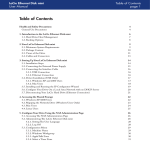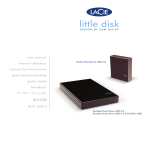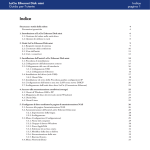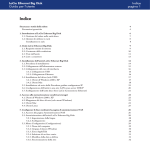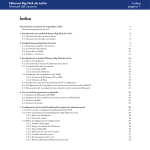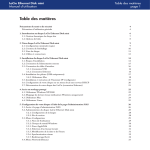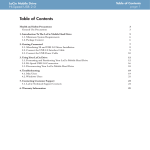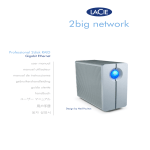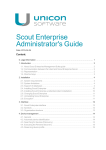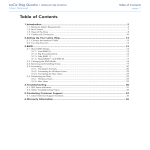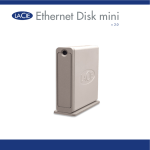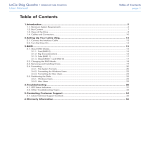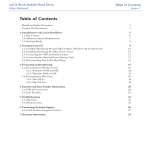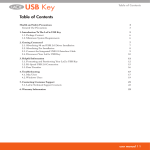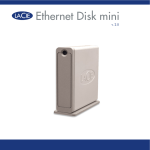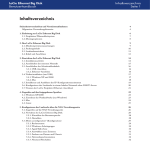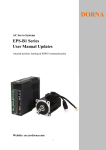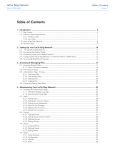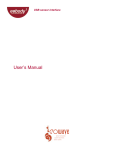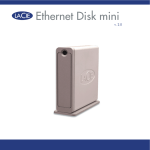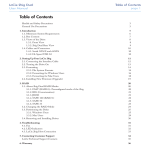Download Ethernet Big Disk User Manual
Transcript
LaCie Ethernet Big Disk User Manual Table of Contents page Table of Contents Health and Safety Precautions General Use Precautions 4 4 1. Introduction to the LaCie Ethernet Big Disk 1.1. Hard Drive Heat Management 1.2. Racking Options 6 7 8 2. Your LaCie Ethernet Big Disk 2.1. Minimum System Requirements 2.2. Package Content 2.3. Views of the Drive 2.4. Cables and Connectors 9 9 10 11 13 3. Setting Up Your LaCie Ethernet Big Disk 3.1. Installation Steps 3.2. Connecting the External Power Supply 3.3. Connecting the Interface Cable 3.3.1. USB Connection 3.3.2. Ethernet Connection 3.4. Driver Installation (USB Only) 3.4.1. Windows XP and 2000 Users 3.4.2. Mac Users 3.5. Installing and Running the IP Configurator Wizard 3.6. Configure Your Drive On a Local Area Network with no DHCP Server 3.7. Disconnecting Your LaCie Hard Drive (Ethernet Connection) 14 14 15 16 16 16 17 17 18 19 20 21 4. Accessing the Shared Storage 4.1. Windows XP/2000 Users 4.2. Mapping the Network Drive (Windows Users Only) 4.3. Mac Users 4.4. Linux Users 22 22 23 24 25 5. Configure Your Drive Using the NAS Administration Page 5.1. Accessing The NAS Administration Page 5.2. Administering The LaCie Ethernet Big Disk 5.2.1. Setting The User Language 5.2.2. Log Off 5.3. Configuration Menu 5.3.1. Machine Name 5.3.2. Windows Workgroup 5.3.3. AppleTalk Zone 5.3.4. Select a Time Zone 26 26 28 28 28 29 29 30 30 31 LaCie Ethernet Big Disk User Manual 5.3.5. Change Date and Time 5.3.6. Network Synchronization 5.3.7. Restart/Shut Down 5.4. Network Menu 5.4.1. IP Configuration 5.5. Disk Menu 5.5.1.Reformatting the Disk 5.5.2.Adding Additional Storage Space 5.6. Shares Menu 5.6.1. Create New Share 5.6.2. Edit a Share 5.7. Users Menu 5.7.1. Add A User 5.7.2. Edit a User 5.7.3. Change Administrator Password 5.9. Status Menu 5.9.1. FTP and HTTP Protocols 5.9.2. System Log Table of Contents page 31 32 32 33 33 35 35 35 36 36 37 37 38 38 39 40 40 40 6. Ethernet Big Disk Media Server Functionality 6.1. About UPnP Media Server 6.2. Configuring Media Server Functions 6.2.1. Enabling the MediaServer 6.2.2. Selecting Shares with Media Content 6.2.3. Restarting the Media Server 41 41 42 42 42 42 7. Troubleshooting 43 8. Contacting Customer Support 8.1. LaCie Technical Support Contacts 46 47 9. Warranty Information 48 Forward page LaCie Ethernet Big Disk User Manual Copyrights Copyright © 2006 LaCie. All rights reserved. No part of this publication may be reproduced, stored in a retrieval system, or transmitted in any form or by any means, electronic, mechanical, photocopying, recording or otherwise, without the prior written consent of LaCie. Trademarks Apple, Mac, and Macintosh are registered trademarks of Apple Computer, Inc. Microsoft, Windows 98, Windows 98 SE, Windows 2000, Windows Millennium Edition and Windows XP are registered trademarks of Microsoft Corporation. Other trademarks mentioned in this manual are the property of their respective owners. Changes The material in this document is for information only and subject to change without notice. While reasonable efforts have been made in the preparation of this document to assure its accuracy, LaCie assumes no liability resulting from errors or omissions in this document, or from the use of the information contained herein. LaCie reserves the right to make changes or revisions in the product design or the product manual without reservation and without obligation to notify any person of such revisions and changes. CAUTION: Modifications not authorized by the manufacturer may void the user’s authority to operate this device. Canada Compliance Statement LaCie Ethernet Big Disk Tested To Comply With FCC standards For Home of Office Use This Class A digital apparatus meets all requirements of the Canadian Interference-Causing Equipment Regulations. FCC Statement This device complies with Part 15 of the FCC Rules. Operation is subject to the following conditions: 1. The devices may not cause harmful interference 2. The devices must accept any interference received, including interference that may cause undesired operation. NOTE: This equipment has been tested and found to comply with the limits for a Class B digital device, pursuant to Part 15 of the FCC Rules. These limits are designed to provide reasonable protection against harmful interference in a residential installation. This equipment generates, uses and can radiate radio frequency energy and, if not installed and used in accordance with the instructions, may cause harmful interference to radio communications. However, there is no guarantee that interference will not occur in a particular installation. If this equipment does cause harmful interference to radio or television reception, which can be determined by turning the equipment off and on, the user is encouraged to try and correct the in- terference by one or more of the following measures: ❖ Reorient or relocate the receiving antenna. ❖ Increase the separation between the equipment and receiver. ❖ Connect the equipment into an outlet on a circuit different from that to which the receiver is connected. ❖ Consult the dealer or an experienced radio/TV technician for help. Modifications to this product not authorized by LaCie could void the FCC & Industry Canada regulations and negate your authority to operate the product. Manufacturer’s Declaration for CE Certification We, LaCie, solemnly declare that this product conforms to the following European standards: Class B EN60950, EN55022, EN50082-1, EN61000-3-2 With reference to the following conditions: 73/23/EEC Low Voltage Directive; 89/336/EEC EMC Directive ROHS Compliance This product is ROHS compliant (European Directive 2002/95/EC on the Restriction of Hazardous Substances). CAUTION: The LaCie Ethernet Big Disk’s warranty may be void as a result of the failure to respect the precautions listed above. Forward page LaCie Ethernet Big Disk User Manual This symbol on the product or on its packaging indicates that this product must not be disposed of with your other household waste. Instead, it is your responsibility to dispose of your waste equipment by handing it over to a designed collec- tion point for the recycling of waste electrical and electronic equipment. The separate collection and recycling of your waste equipment at the time of disposal will help to conserve natural resources and ensure that it is recycled in a manner that protects human health and the environment. For more information about where you can drop off your waste equipment for recycling, please contact your local city office, your household waste disposal service, or the shop where you purchased the product. Health and Safety Precautions ❖ Only qualified persons are authorized to carry out maintenance on this device. ❖ Read this User Manual carefully and follow the correct procedure when setting up the device. ❖ Do not open your LaCie Ethernet Big Disk or attempt to disassemble or modify it. Never insert any metallic object into the drive to avoid any risk of electrical shock, fire, shortcircuiting or dangerous emissions. Your LaCie Ethernet Big Disk contains no user-serviceable parts. If it appears to be malfunctioning, have it inspected by a qualified LaCie Technical Support representative. ❖ Never expose your device to rain, or use it near water, or in damp or wet conditions. Never place objects containing liquids on the LaCie Ethernet Big Disk, as they may spill into its openings. Doing so increases the risk of electrical shock, short-cir- cuiting, fire or personal injury. ❖ Make sure that the computer and LaCie Ethernet Big Disk are electrically grounded. If the devices are not grounded, there is an increased risk of electrical shock. Power requirements 100-240 V~, 1.5 A, 6050 Hz, (Supply voltage fluctuations not exceeding ± 10% of the nominal, transient over-voltages according to over-voltage category II). General Use Precautions ❖ Do not expose the LaCie Ethernet Big Disk to temperatures outside the range of 5° C to 35° C (41° F to 95° F); or to operational humidity beyond 5-80%, non-condensing, or non-operating humidity beyond 10-90%, non-condensing. Doing so may damage the LaCie Ethernet Big Disk or disfigure its casing. Avoid placing your LaCie Ethernet Big Disk near a source of heat or exposing it to sunlight (even through a window). Inversely, placing your LaCie Ethernet Big Disk in an environment that is too cold or humid may damage the unit. ❖ Always unplug the LaCie Ethernet Big Disk from the electrical outlet if there is a risk of lightning or if it will be unused for an extended period of time. Otherwise, there is an increased risk of electrical shock, short-circuiting or fire. ❖ Use only the power supply shipped with the device. ❖ Do not use the LaCie Ethernet Big Disk near other electrical appliances such as televisions or radios. Doing so may cause interference which Forward page LaCie Ethernet Big Disk User Manual will adversely affect the operation of the other products. ❖ Do not place the LaCie Ethernet Big Disk near sources of magnetic interference, such as computer displays, televisions or speakers. Magnetic interference can affect the operation and stability of your LaCie Ethernet Big Disk. Do not place heavy objects on top of the LaCie Ethernet Big Disk or use excessive force on it. ❖ Never use excessive force on your LaCie Ethernet Big Disk. If you detect a problem, see the Troubleshooting section in this manual. CAUTION: A shielded-type power cord is required in order to meet FCC emission limits and also to prevent interference to the nearby radio and television reception. It is essential that only the supplied power cord be used. Important Info: 1GB = 1,000,000,000 bytes. 1TB = 1,000,000,000,000 bytes. Once formatted, the actual available storage capacity varies depending on operating environment (typically 10-15% less). 1GB = 1,000,000,000 bytes. 1TB = 1,000,000,000,000 bytes. Important Info: Any loss, corruption or destruction of data while using a LaCie drive is the sole responsibility of the user, and under no circumstances will LaCie be held liable for the recovery or restoration of this data. To help prevent the loss of your data, LaCie highly recommends that you keep TWO copies of your data; one copy on your external hard drive, for instance, and a second copy either on your internal hard drive, another external hard drive or some other form of removable storage media. LaCie offers a complete line of CD and DVD drives. If you would like more information on backup, please refer to our website. LaCie Ethernet Big Disk User Manual 1. Introduction to the LaCie Ethernet Big Disk Congratulations on the purchase of your new LaCie Ethernet Big Disk. By simply plugging the LaCie Ethernet Big Disk into your Ethernet-based network, you can easily share documents, data or multi-media files. Connect the LaCie Ethernet Big Disk either directly to a computer via USB, or share the drive over your network through the Ethernet connection. When connected through USB, the LaCie Ethernet Big Disk performs like a standard network hard drive, and you can also still modify and configure the network settings, as well. When connected to a network, the LaCie Ethernet Big Disk becomes a Network Attached Storage device, capable of supporting a limited number of users connecting simultaneously. You can easily manage the LaCie Ethernet Big Disk through the Internet with the Web Administration tool – create users, assign access rights and passwords and configure the network parameters of your drive. ■ Your LaCie Ethernet Big Disk Capabilities ❖ Back up data in a separate location, away from the source ❖ Centralize your digital media content ❖ Stream audio/video content to any media player (UPnP DLNA compatible) ❖ Share files between Mac, Windows and Linux clients Introduction page Introduction page LaCie Ethernet Big Disk User Manual 1.1. Hard Drive Heat Management ■ Heat Dissipation Design USB 2.0 USB The LaCie Ethernet Big Disk’s metal body is ideal for naturally dissipating internal drive heat. Its unique design actually draws heat away from the internal drive toward the external casing. The casing absorbs heat and will take advantage of its large surface to further dissipate heat outside the casing. Because of this advantageous feature, heat is taken away from the internal drive, keeping it safe and prolonging its life and reliability. As a consequence, it is normal that the external casing is hot to the touch. Please make sure that the vents of the back-bezel and front-bezel are not obstructed so that there is a natural airflow across the casing. Fig 1.1.A ■ Upright, Stack & Rackmount Configuration Heat dissipation is maximized when the drive is in the upright position (Fig. 1.1.B.). If you have several LaCie drives stacked on each other, please remember to attach the included rubber feet on the under side of your drives. This will allow for some airflow between your drives so that the heat dissipation can work effectively - especially if your LaCie drive does not include a fan. LaCie does not recommend stacking or racking more than 3 d2 drives on top of each other (Fig. 1.1.D.), especially if these drives are turned ON simultaneously. Fig 1.1.B ■ Smart Fan Technology The casing alone is a great way to dissipate heat without the need of a fan. Therefore, currently, most drives do not require a fan. Only the largest capacity drives may need a fan. To find out if your drive includes a fan, please refer to the item number and product datasheet. Some models of the Ethernet Big Disk have a thermoregulated “smart fan”, which activates when the heat inside the casing reaches a certain temperature. The smart fan operates at two different speeds, and adjusts automatically to changes in temperature. Fig 1.1.D Fig 1.1.C Introduction page LaCie Ethernet Big Disk User Manual 1.2. Racking Options ■ Standalone Installation Fig. 1.2.A The LaCie Ethernet Big Disk includes a convenient drive stand, which allows the drive to be placed in an upright position. Please refer to the instruction sheet included with the drive stand for specific instructions. ■ Rackmount Installation Fig. 1.2.B The LaCie Ethernet Big Disk can be incorporated into standard 19” computer equipment racks, using the LaCie Rackmount Kit (sold separately). Please refer to the instructions included with the LaCie Rackmount Kit for specific instructions. Your LaCie Ethernet Big Disk page LaCie Ethernet Big Disk User Manual 2. Your LaCie Ethernet Big Disk 2.1. Minimum System Requirements ■ Windows Users ■ Mac Users ❖ Pentium II 233MHz processor ❖ G4 Power Mac ❖ Windows 98SE, Me, 2000, XP ❖ OS 9x ❖ Ethernet 10/100 Network adapter ❖ Ethernet 10/100 Network adapter ❖ Web browser (Internet Explorer®, Mozilla™) ❖ Web browser (Internet Explorer®, Safari™, Mozilla™) ❖ Wired or wireless switch or router ❖ Wired or wireless switch or router ❖ Internet access ❖ Internet access Important Info: The LaCie Ethernet Big Disk is compatible with the MacIntel processors. Important Info: The LaCie Ethernet Big Disk is compatible with Gigabit and Fast Ethernet switches and routers. Important Info: The Ethernet Big Disk’s performance is affected heavily by such external forces as network activity, hardware, distance and setup. Important Info: For optimal performance, use a Gigabit Ethernet router and a Gigabit Ethernet board in your host PC or MAC. Your LaCie Ethernet Big Disk page 10 LaCie Ethernet Big Disk User Manual 2.2. Package Content Your LaCie Ethernet Big Disk should contain the following: 1 LaCie Ethernet Big Disk 2 Vertical stand kit 3 Ethernet cable 4 Hi-Speed USB 2.0 cable 5 External power supply 6 Quick Install Guide 7 LaCie Storage Utilities CD-ROM 1 3 2 5 6 8 7 ethernet big disk LaCie Storage Utilities Quick Install Guide Important Info: Please save your packaging. In the event that the drive should need to be repaired or serviced, it must be returned in its original packaging. Your LaCie Ethernet Big Disk page 11 LaCie Ethernet Big Disk User Manual 2.3. Views of the Drive ■ Front View 1 Fig. 2.3.A 1 On/Off Button / Power LED /Activity LED Press the On/Off Button to power the drive on and off. Press the button for 5 seconds to power off the drive. The LED remains lit to show that the drive is on, and blinks to indicate drive activity. Important Info: Do not unplug the power chord or turn off the power strip to turn the Ethernet Big Disk on or off. Press the On/Off power button for 5 seconds to properly shut down the drive. Important Info: The Ethernet Big Disk will restart automatically after a power failure. Your LaCie Ethernet Big Disk page 12 LaCie Ethernet Big Disk User Manual ■ Rear View 1 2 3 4 6 5 USB USB 2.0 7 Mac Address: 00D04B801220 SN:XXXXXXXXXX Fig. 2.3.B 9 1 Lock Slot – This slot is used to connect an antitheft system, such as the LaCie Security Lock, for maximum protection. Refer to your antitheft system documentation for details on how to connect the lock. 2 Power Supply Connector – This is where you plug in the AC adapter supplied with the drive. See section 3.2. Connecting The External Power Supply for more information. 3 Hi-Speed USB 2.0 Port – This is where you plug in the USB cable that connects the drive to your computer. 4 Hi-Speed USB 2.0 Expansion Port – This is where you plug in the USB cable that connects another USB external drive to the Ethernet Big Disk to extend the storage capacity. 5 Gigabit Ethernet Port – This is where you plug in the Ethernet cable furnished with the drive. See section 3.3. Connecting the Interface Cable for more information (also compatible with Fast Ethernet 10/100). 6 Ventilation Outlet – These holes help to keep your drive cool during operation. Be sure not to block these openings when using your drive. 8 7 Rackmount Grooves – These grooves are used for mounting the drive in the Desk Rack kit (sold separately) or placing your drive in standard 19” computer equipment racks using the LaCie Rackmount Kit (sold separately). See sections 1.2. Racking Options for more information. 8 Serial Number Sticker – This is where you will find your LaCie drive’s serial number. Write down the serial number and keep it in a safe place, because you will need to provide the number in the event you have to call LaCie Technical Support for any reason in regards to the drive’s performance. The serial number would also come in handy if your drive is lost or stolen. 9 MAC Address – Every network device has a unique Mac Address (Media Access Control). This address can be found on the back of your Ethernet Big Disk. Your LaCie Ethernet Big Disk page 13 LaCie Ethernet Big Disk User Manual 2.4. Cables and Connectors The LaCie Ethernet Big Disk offers two different methods for connection and usage. ■ Gigabit Ethernet Ethernet Icon This icon will help you easily identify the ethernet interface. It appears on the back of the Ethernet Big Disk and next to the ethernet port connectors on certain computers. Ethernet Hardware This illustration will help you to identify the Ethernet cable and port. Fig. 2.4.B Ethernet Cable and Cable End Fig. 2.4.A Ethernet icon ■ Hi-Speed USB 2.0 USB Icons These icons will help you easily identify the USB interfaces. They appear on USB cables and next to the USB port connectors on certain computers. USB 2.0 Hardware This illustration will help you to identify the USB 2.0 cable and port. Fig. 2.4.E: USB 2.0 Cable and Cable End Fig. 2.4.C: USB 2.0 icon Fig. 2.4.D: USB 1.1 icon LaCie Ethernet Big Disk User Manual Setting Up Your Ethernet Big Disk page 14 3. Setting Up Your LaCie Ethernet Big Disk 3.1. Installation Steps You have the option of connecting your Ethernet Big Disk to a LAN via Ethernet (to be able to share your drive with other computers on the network) or directly to a computer via USB (to use your drive as a personal storage device). For either use, there are several steps to getting your Ethernet Big Disk up and running: Ethernet Connection Step 1 Connecting the External Power Supply Page 15 Step 2 Connecting the Ethernet Cable Page 16 Step 3 Installing and Running the IP Configurator Wizard Page 19 USB Connection Step 1 Connecting the External Power Supply Page 15 Step 2 Connecting the USB Cable Page 16 Step 3 Driver Installation (USB Only) Page 17 Step 4 Installing and Running the IP Configurator Wizard Page 19 Important Info: The Ethernet and USB cables can be connected simultaneously only if there is a DHCP server on the network or machine. Setting Up Your Ethernet Big Disk page 15 LaCie Ethernet Big Disk User Manual 3.2. Connecting the External Power Supply There are two cables that are supplied with the power supply: one cable (A) connects to the LaCie Ethernet Big Disk; and the other cable (B) connects to a power outlet, such as a wall outlet or a surge protector. USB USB 2.0 A Fig. 3.2.A 1. Connect Cable A to your LaCie Ethernet Big Disk. 2. Connect Cable B to the Power Supply brick (C). 3. Connect Cable B to a surge protector or wall outlet. You are now ready to connect the interface cable to your drive and to your computer. B C Setting Up Your Ethernet Big Disk page 16 LaCie Ethernet Big Disk User Manual 3.3. Connecting the Interface Cable The Ethernet Big Disk gives you the option to connect either a USB or Ethernet cable. However, the Ethernet and USB cables can be connected simultaneously only if there is a DHCP server on the network or machine. ■ 3.3.1. USB Connection ■ 3.3.2. Ethernet Connection A Fig. 3.3.1.A. 1. Connect the USB cable into the USB port on the back of the LaCie Ethernet Big Disk (A). Fig. 3.3.1.B. USB USB 2.0 USB USB 2.0 A Fig. 3.3.2.A. 1. Connect the Ethernet cable into the Ethernet port on the back of the LaCie Ethernet Big Disk (A). Fig. 3.3.2.B. B B To Ethernet Big Disk To Ethernet Big Disk 2. Connect the other end of the Hi-Speed USB 2.0 cable into an available USB port on your computer (B). 3. Press the blue On/Off Button on the front of the drive. Now move on to step 3, 3.4., Driver Installation (USB only). 2. Connect the other end of the Ethernet cable into an available Ethernet port on your router (B). 3. Press the blue On/Off Button on the front of the drive. It may take a few seconds for your network to recognize the drive. Now move on to step 3, 3.5., Installing and Running the Configuration Wizard. LaCie Ethernet Big Disk User Manual Setting Up Your Ethernet Big Disk page 17 3.4. Driver Installation (USB Only) ■ 3.4.1. Windows XP and 2000 Users 1. Once the Ethernet Big Disk is plugged in via USB, a window will appear saying that new hardware has been detected (Fig. 3.4.A.). 2. Then, if the driver has not already been installed, Windows will ask to install it. Fig. 3.4.A. 3. When Windows asks if it can connect to Windows Update to search for the driver, select No, not at this time and click Next (Fig. 3.4.B.). k Disni t rnek mi e Etht Dis e i e LaCthern E 4. Insert the Ethernet Big Disk Storage Utilities CD-ROM. When Windows asks, What do you want the wizard to do?, select Install the Software Automatically (Recommended) (Fig. 3.4.C.). 5. Once the device is detected and the driver is loaded, the task bar in the lower right hand corner of your screen will show the following icon, which indicates that the network interface is being initialized either with DHCP* (if available) or with APIPA**: Fig. 3.4.B. 6. Once the wizard has finished, click Finish and move on to the next step, 3.5., Installing and Running the Configuration Wizard. Technical note: * DHCP is a client/server based protocol that is used to assign IP addresses in a network. Fig. 3.4.B. ** APIPA is a “light” protocol that is used by DHCP clients when no DHCP servers are available (or until the DHCP server becomes available). APIPA is a kind of “fallback” to get an IP address compatible with the network defined by 169.254.0.0/255.255.0.0 (or 169.254.0.0/16). Fig. 3.4.C. LaCie Ethernet Big Disk User Manual Setting Up Your Ethernet Big Disk page 18 ■ 3.4.2. Mac Users 1. Once the Ethernet Big Disk is plugged in via USB, open System Preferences from the Dock or your Applications folder (Fig. 3.4.2.A.). 2. Select the Network icon from the Internet & Network section. 3. The Network preference pane will display a message stating that a new network interface has been recognized (Fig. 3.4.2.B.). Click OK. Fig. 3.4.2.A. 4. The device is ready. If APIPA (see note at the bottom of page 17) has been used, the Network preference pane will say that the new interface will use a “self-assigned IP address” (Fig. 3.4.2.C.). 5. You can check the IP address by clicking on the “Configure...” button. 6. Move on to the next step, 3.5., Installing and Running the Configuration Wizard. Fig. 3.4.2.B. Fig. 3.4.2.C. LaCie Ethernet Big Disk User Manual Setting Up Your Ethernet Big Disk page 19 3.5. Installing and Running the IP Configurator Wizard ■ PC Users 1. Insert the LaCie Ethernet Big Disk CD-ROM into your computer’s CD-ROM drive. 2. In your My Computer folder, double click the CDROM drive. Double click “Install the IP configurator”. 3. Follow the Wizard to complete installation. 4. If the IP configurator doesn’t open, select the program from the Start Menu. 5. Follow the steps indicated in the Wizard. Once the Wizard locates your Ethernet Big Disk (represented by its IP address), select it and click Connect (Figs. 3.5.A. - 3.5.C.). Fig. 3.5.A. Important Info: The IP configurator can be used to detect the Ethernet Disk minis connected via Ethernet as well as USB. ■ Mac Users 1. Insert the LaCie Ethernet Big Disk CD-ROM into your computer’s CD-ROM drive. 2. The CD should appear on the desktop. Double click the CD icon, then double click “Install the IP configurator”. Fig. 3.5.B. Important Info: The Wizard installer will requrest Administrator rights to complete installation (Mac/PC/Linux users). 3. Follow the Wizard to complete installation. 4. From the application folder, open Utilities / LaCie IP Configurator. 5. Follow the steps indicated in the Wizard. Once the Wizard locates your Ethernet Big Disk (represented by its IP address), select it and click Connect (Figs. 3.5.A. - 3.5.C.). Fig. 3.5.C. LaCie Ethernet Big Disk User Manual Setting Up Your Ethernet Big Disk page 20 3.6. Configure Your Drive On a Local Area Network with no DHCP Server In the case that your server is not DHCP-enabled, you will need to manually assign the correct network settings for your LaCie Ethernet Big Disk. The easiest way to modify your LaCie Ethernet Big Disk’s network configuration is to use the LaCie IP Configurator. See chapter 3.5. Installing and Running the Configuration Wizard for information on installing the network configuration software. 1. Run the software from the Start Menu (PC users) or the Utilities folder (Mac users). 2. When the Wizard opens, select Advanced Mode. 3. Uncheck the “DHCP” box (Fig. 3.6.A.). 4. Modify the network settings to work with your network. Fig. 3.6.A. LaCie Ethernet Big Disk User Manual Setting Up Your Ethernet Big Disk page 21 3.7. Disconnecting Your LaCie Hard Drive (Ethernet Connection) There are two ways to disconnect the Ethernet connection. ❖ From the Web administration page, click on the configuration tab and then click on the shutdown button (see chapter 5., Configure Your Drive Using the NAS Administration Page for more information) (Fig. 3.7.A.). OR, ❖ Press the On/Off button on the front of the LaCie Ethernet Big Disk, and hold the button down for 3 seconds. The On/ Off button will flicker for a few seconds before powering off. Fig. 3.7.A. Accessing the Share page 22 LaCie Ethernet Big Disk User Manual 4. Accessing the Shared Storage 4.1. Windows XP/2000 Users Important Info: If you have just turned on the LaCie Ethernet Big Disk, it may take a few moments for the LaCie Ethernet Big Disk to appear on the network. 1. To access the share in Windows, look in My Network Places, and select Microsoft Windows Workgroup. By default, the Ethernet Big Disk will be named EthernetBD (Fig. 4.1.A.). Fig. 4.1.A. Alternatively, you can access the share by typing the following in a Windows explorer address field (Fig. 4.1.B.): \\EthernetBD \\[IP address] (to find your Ethernet Big Disk’s IP address, run the IP Configurator Wizard; see chapter 3.5). For FTP access, type: ftp://EthernetBD or ftp://[IP address] 2. In the logon window that opens (Fig. 4.1.C.), type: User Name: admin Password: admin (This user name and password is the factory default; if you have already created a user, input your user name and password.) Fig. 4.1.B. 3. The LaCie Ethernet Big Disk will appear as a drive with one share folder on the network. For faster connections and usability, LaCie recommends you map the network drive. For details, see chapter 4.2. Mapping the Network Drive (Windows Users Only). ■ Windows 95/98/98SE From the Start menu, select Find and then Computer. Enter EthernetBD as the server name and click Fig. 4.1.C. Accessing the Share page 23 LaCie Ethernet Big Disk User Manual Find Now. Windows will search your system and after a little while, the LaCie Ethernet Big Disk should appear in the result window. Click on the icon, and you will then be asked to enter a username and password. ■ Windows Me/2000 For Windows Me and Windows 2000 users, if you cannot find the LaCie Ethernet Big Disk from your workstation, try using the Windows search tool. From the Start menu, select Search, and then click on For Files or Folders. In the Search Results window, select Computers. In the Search for Computers dialog box, enter the server name and click the Search Now button. By default, the LaCie Ethernet Big Disk will be named “EthernetBD” , and the share “SHARE”. 4.2. Mapping the Network Drive (Windows Users Only) For faster time connections and usability, LaCie recommends that you map your shared drive. To map a shared drive: 1. Select the Tools menu from Windows Explorer. 2. Click on Map a drive. 3. Fill in the appropriate information (Fig. 4.2.A.) and press Finish. This creates a direct access to the shared drive from My Computer (for more information about drive mapping, refer to your Windows manual). Fig. 4.2.A. Technical note: Windows Me Users – To access your shares under Windows Me, the administrator will need to create a user with the same username and password as your log in for Windows. This is due to a limitation in Microsoft’s operating system. Technical note: Windows 95 and 98 Users – To access your shares under Windows 95 and 98, you will need to create a user on the LaCie Ethernet Big Disk with the same user name and password as your log in for Windows. This is due to a limitation in Microsoft’s operating system. Accessing the Share page 24 LaCie Ethernet Big Disk User Manual 4.3. Mac Users Important Info: If you have just turned on the LaCie Ethernet Big Disk, it may take a few moments for the LaCie Ethernet Big Disk to appear on the network. 1. Run the Network IP Configurator Wizard. 2. The Wizard will search for connected Ethernet Big Disk(s) on your network (Fig. 4.3.A.). Found Ethernet Disk minis will be represented by an IP address. 3. Write down this IP address (for example, 10.1.4.4). 4. From the Finder, click Go and select Connect to Server... 5. In the Server Address field, type your Ethernet Big Disk’s IP address and click Connect (Fig. 4.3.B.). Fig. 4.3.A. For SMB access, type Apple-K, and in the address field, type smb://EthernetBD (it is also possible to type smb://IP address or smb://Machine name). For FTP access, type Apple-K, and in the address field, type ftp://EthernetBD or ftp://IP Address. For AFP access, type Apple-K, and in the address field, type afp://EthernetBD or afp://IP Address. 6. In the logon window that opens, type: User Name: admin Password: admin (This user name and password is the factory default; if you have already created a user, input your user name and password.) 7. In the Select Volumes to Mount window, select EthernetBD and click OK. The network drive will mount on your desktop (Fig. 4.3.C.) and can be accessed for file transfer. Fig. 4.3.B. ■ Mac OS 9.x From the Apple menu, select Network Browser, Chooser or Connect to Server. In Chooser, click the Appleshare icon. Your server should appear in the list with the default name “EthernetBD”. Select it and press OK. Fig. 4.3.C. LaCie Ethernet Big Disk User Manual 4.4. Linux Users Under KDE, open konqueror and type in the IP address of the LaCie Ethernet Big Disk into the address field: ❖ For FTP access – ftp:// [IP address] ❖ For HTTP access – http:// [IP address] ❖ For SMB/CIFS access (in order for this to method to work, the services need to be properly configured) – smb:// [IP address]. Accessing the Share page 25 Using the NAS Administration Page page 26 LaCie Ethernet Big Disk User Manual 5. Configure Your Drive Using the NAS Administration Page The LaCie Ethernet Big Disk features an easy-touse Web-based tool for configuring the drive and administering users. 5.1. Accessing The NAS Administration Page There are two ways of accessing the NAS Administration page, Using the IP Configurator Wizard, and Using the Browser. ■ Using the IP Configurator Wizard 1. Select the program from the Start Menu (PC users) or from the Applications folder (Mac users). 2. Follow the steps indicated in the Wizard. Once the Wizard locates your Ethernet Big Disk (represented by its IP address), select it and click Connect (Figs. 5.1.A. - 5.1.B.). Fig. 5.1.A. 3. Once the NAS Administration Page opens in your default browser, click on the Administration link. 4. In the logon window that opens, type: User Name: admin Password: admin (This user name and password is the factory default; if you have already created a user, input your user name and password. This is the administration logon and you can change it for more security if you choose.) The NAS Administration page will open in your default browser. Fig. 5.1.B. LaCie Ethernet Big Disk User Manual Using the NAS Administration Page page 27 ■ Using the Browser 1. In your browser’s address field, type one of the following: http://EthernetBD (Fig. 5.1.C.) or http:// + IP address (find the IP address by running the IP Configuration Wizard) Fig. 5.1.C. 2. Once the NAS Administration Page opens in your default browser, click on the Administration link. 3. In the logon window that opens (Fig. 5.1.D.), type: User Name: admin Password: admin (This user name and password is the factory default; if you have already created a user, input your user name and password.) The NAS Administration page will open in your default browser. Fig. 5.1.D. LaCie Ethernet Big Disk User Manual Using the NAS Administration Page page 28 5.2. Administering The LaCie Ethernet Big Disk After the login is validated, you will enter the LaCie Ethernet Big Disk’s Web Administration Page. Along the top of the page are a series of tabs (Configuration, Network, Disk, Shares, Users, Media and Status), from which you can navigate and configure the LaCie Ethernet Big Disk. ■ 5.2.1. Setting The User Language The first page that appears will give you the opportunity to select the language that you wish to use for the Web Administration Page. Simply use the pull-down menu beside the Language selector to find your language, and then click Submit Changes to activate your language. You may come back to this page at any time by clicking on the language’s flag, located just below the program tabs (Fig. 5.2.1.A.). ■ 5.2.2. Log Off Fig. 5.2.1.A. You can close the Web Administration program at any point while the Web page is open by clicking Log Off, located just below the tabs in the upper-right hand corner of the screen. After clicking Log Off, click on the Close Window button to leave the program (Fig. 5.2.2.A.). Fig. 5.2.2.A. Technical note: Depending on your browser settings, clicking the “Log Off ” button may or may not close the browser window. LaCie Ethernet Big Disk User Manual Using the NAS Administration Page page 29 5.3. Configuration Menu By clicking on the Configuration tab, you will be brought to the main page of the Configuration menu. From this window you can see details about your network, software and hardware, while also being able to restart or shutdown your LaCie Ethernet Big Disk (Fig. 5.3.A). Important Info: The Configuration page allows you to check the software version of your drive. ■ 5.3.1. Machine Name Fig. 5.3.A. Here you can change the Ethernet Big Disk’s name. Type the name and click the Submit Changes button. The default machine name for the LaCie Ethernet Big Disk is “EthernetBD” (Fig. 5.3.1.A.). Important Info: If you intend to use more than one Ethernet Big Disk on your network, you must change the default machine name. Each Ethernet Big Disk must have a unique name. Fig. 5.3.1.A. Technical note: Machine name changes will be registered in the local DNS servers ONLY after a restart. LaCie Ethernet Big Disk User Manual Using the NAS Administration Page page 30 ■ 5.3.2. Windows Workgroup The Ethernet Big Disk is first attached by default to the Windows Workgroup. On this page, you can modify the workgroup to which the LaCie Ethernet Big Disk is attached. If you have altered the workgroup, click the Submit Changes button to activate your changes (Fig. 5.3.2.A.). Fig. 5.3.2.A. ■ 5.3.3. AppleTalk Zone CAUTION: A workgroup name can contain up to 15 characters, including letters, numbers, and the following characters: ! @ # $ % ^ & ( ) _ - ; : ‘” , . It cannot contain any spaces, and must begin with a letter or number. Here you can modify the AppleTalk Zone to which the LaCie Ethernet Big Disk is attached. If you have altered the AppleTalk Zone, click the Submit Changes button to activate your changes (Fig. 5.3.3.A.). Fig. 5.3.3.A. LaCie Ethernet Big Disk User Manual Using the NAS Administration Page page 31 ■ 5.3.4. Select a Time Zone Here you can modify the Time Zone to which the LaCie Ethernet Big Disk is attached. If you have altered the Time Zone, click the Submit Changes button to activate your changes (Fig. 5.3.4.A.). Fig. 5.3.4.A. ■ 5.3.5. Change Date and Time Here you can modify the date and time settings of the LaCie Ethernet Big Disk. If you have altered the date and time, click the Submit Changes button to activate your changes (Fig. 5.3.5.A.). Fig. 5.3.5.A. LaCie Ethernet Big Disk User Manual Using the NAS Administration Page page 32 ■ 5.3.6. Network Synchronization If you have altered the date and time, click the Submit Changes button to activate your changes. There are two ways to set up network synchronization (but you can’t use both ways). First, opt to manually assign time and date settings (Fig. 5.3.6.A.): 1. First, input time and date settings. 2. Then, select the source (Windows workgroup or specify server name). The second way to set up synchronization is to select the Windows Workgroup or server and to enter the server name. Fig. 5.3.6.A. ■ 5.3.7. Restart/Shut Down At the bottom of the Configuration menu, you can press either the Restart button or Shutdown button. By clicking on either of the buttons, a prompt will appear to alert you to which process is taking place. LaCie Ethernet Big Disk User Manual Using the NAS Administration Page page 33 5.4. Network Menu On this page you can view information about the LaCie Ethernet Big Disk’s IP configuration. From this page, you can also modify the IP configuration of the LaCie Ethernet Big Disk (Fig. 5.4.A.). On this page, the connected interface will be represented by a blue button, and the disconnected interface by a red button. Only settings for connected interfaces can be modified. ■ 5.4.1. IP Configuration On this page, you can check which interface is connected, either the Ethernet, or USB or both and then to configure the connection. Fig. 5.4.A. There are two alternative methods for determining the LaCie Ethernet Big Disk’s IP address: Obtain Configuration From DHCP Server or Configure Manually (Fig. 5.4.1.A.). Obtain Configuration From DHCP Server This method is used when the LaCie Ethernet Big Disk is connected to a DHCP enabled network with a DHCP server. In this case, the server automatically assigns the IP address for the LaCie Ethernet Big Disk. Configure Manually This method is used when the LaCie Ethernet Big Disk is connected to a non-DHCP enabled network. In this case, you will need to manually assign the correct network settings for your LaCie Ethernet Big Disk. Please refer to your network administrator for more information about your network and which parameters you should use. For more information, refer to chapter 3.6., Configure Your Drive On a Local Area Network with no DHCP Server. Fig. 5.4.1.B. Technical note: If you have a small home network with a router, the Gateway and DNS Server address will be the local IP address of your router. LaCie Ethernet Big Disk User Manual IP Address – This is the IP address that you want to assign to the LaCie Ethernet Big Disk. Subnet Mask – This is the subnet mask that is associated with the LaCie Ethernet Big Disk’s assigned IP address. Default Gateway – This is the default IP address of the Gateway that is available for the specified network. Using the NAS Administration Page page 34 Important Info: If the DHCP server’s automatic IP address configuration function is selected/activated and there is no DHCP server on the network, the Ethernet Big Disk will check first the DHCP, then the APIPA. If no address is found, the following address: 169.254.X.X/255.255.0.0 will be assigned. DNS Server – This is the IP address of the DNS server which handles the routing and resolution of names. JumboFrame Size - The Ethernet Big Disk supports frame (i.e. packets) sizes larger than 1500 bytes on the Gigabit Ethernet interface. JumboFrame capability extends supported frame size to 9000 bytes (9KB). In general, the higher the frame size, the better the network performance. Important Info: Do not modify the JumboFrame size if your network is not configured for JumboFrame functionality. Fig. 5.4.1.C LaCie Ethernet Big Disk User Manual Using the NAS Administration Page page 35 5.5. Disk Menu From this window you can see details about your LaCie Ethernet Big Disk’s interface, volume size, used and free space and file system being used (Fig. 5.5.A.). ■ 5.5.1.Reformatting the Disk By clicking on the Format button, you will launch the Format a disk window, where you will be issued a warning about the formatting process. Read the warning before continuing. Fig. 5.5.1.A. Keep in mind that the file system format cannot be changed. Mac Address: 00D04B801220 SN:XXXXXXXXXX Fig. 5.5.2.A. ■ 5.5.2.Adding Additional Storage Space You can add additional storage space to your LaCie Ethernet Big Disk by connecting an external hard drive using the Hi-Speed USB 2.0 port. 1. Connect the hard drive to the LaCie Ethernet Big Disk using the Hi-Speed USB 2.0 port (Fig. 5.5.2.A.). 2. In the Web Administration Page, click on the Disk tab. 3. One volume is automatically created that you can’t reformat from the Administration page (Fig 5.5.2.B.). 4. Refresh the page if necessary (under Windows in either Internet Explorer or Netscape Navigator, rightclick in the frame and click on Refresh or Reload). USB USB 2.0 Click the Format button to continue, or the Close this window button to quit the process (Fig. 5.5.1.A.). Fig. 5.5.2.B. 5. A share has been added in the list on the share page called usbdisk0_1 (Fig. 5.5.2.C.). Fig. 5.5.2.C. LaCie Ethernet Big Disk User Manual Accessing External Hard Drives Because the external hard drive appears as an Ethernet Big Disk share, access the external hard drive volume as you would for Ethernet Big Disk shares. Refer to chapter 5.5. for details. Once the drive is recognized, Users can be assigned access (by default, Users will not have access). See chapter 5.7. Users Menu for details. Important Info: By default, only the administrator has access to the external storage. Using the NAS Administration Page page 36 Important Info: The Ethernet Big Disk supports drives formatted with the following file systems: MS-DOS/FAT 32, HFS+ and Linux file system formats (ext2/ext3/reiserfs) Technical note: If there is a partition on the external USB drive, each partition will appear as one share in the Ethernet Big Disk. By default, all services (FTP, HTML, etc.) are activated. 5.6. Shares Menu From this window you will be able to create and to select a share and to modify its properties. You can choose from Windows, Apple, Bonjour, HTTP or FTP (Fig. 5.6.A.). Fig. 5.6.A. ■ 5.6.1. Create New Share From this window you will be able create a share. First, click on Create a new share..., then choose a name for the new share, then select the protocols which will be used to access the Ethernet Big Disk. You can choose from Windows, Apple, Bonjour, HTTP or FTP (Fig. 5.6.1.A.). Fig. 5.6.1.A. LaCie Ethernet Big Disk User Manual Using the NAS Administration Page page 37 ■ 5.6.2. Edit a Share From this window you will be able to change properties of your share, such as changing the share’s name and enabling/disabling protocols which will be used to access the share and give users privileges (either readonly or readwrite) (Fig. 5.6.2.A.). Technical note: The names of shares & users will be changed automatically to lower case to avoid any problems. CAUTION: The name cannot contain any of the following characters: \ / [ ] : | < > + = ; , ? * @ and space. 5.7. Users Menu Fig. 5.6.2.A. From this window you will be able to manage your users by creating new users and modifying their password, as well as changing the Administrator’s password (Fig. 5.7.A.). Fig. 5.7.A. Technical note: By default, newly created users do not have access to any shares. LaCie Ethernet Big Disk User Manual Using the NAS Administration Page page 38 ■ 5.7.1. Add A User 1. Click on the Users tab. 2. By clicking on the Add new user line, you will be able to create a new user and assign them a name, password and access privileges (Fig. 5.7.1.A.). ■ 5.7.2. Edit a User Fig. 5.7.1.A. By clicking on the blue button to the right of a user’s name, you will be able to modify passwords and to delete a user (Fig. 5.7.2.A.). Fig. 5.7.2.A. CAUTION: The name cannot contain any of the following characters: \ / [ ] : | < > + = ; , ? * @ and space. LaCie Ethernet Big Disk User Manual Using the NAS Administration Page page 39 ■ 5.7.3. Change Administrator Password On this page, you can alter the default administrator password to a custom password of your own choosing. For security purposes, it is recommended that you alter the default password, and write down and store the new password in a secure location (Fig. 5.7.3.A.). Technical note: By default, the administrator logon is “admin” and the password is “admin”. Fig. 5.7.3.A. LaCie Ethernet Big Disk User Manual Using the NAS Administration Page page 40 5.9. Status Menu From this window you can view the number of connected users, disable file server services (Windows, Apple, HTTP, FTP, Media Server and Bonjour) and view the system log. To disable a service, simply click the Disable button that corresponds to the service which you wish to disable (Fig. 5.9.A.). ■ 5.9.1. FTP and HTTP Protocols HTTP (hypertext transfer protocol) is always active and cannot be turned off. FTP (file transfer protocol), however, can be enabled or disabled. To disable FTP for the Ethernet Big Disk, click on the Status tab and, under Services, click the Disable button that corresponds to the FTP service entry (Fig. 5.9.A.). ■ 5.9.2. System Log On this page, you can download a log of Ethernet Big Disk activities. Click the Clear Log button to start a fresh log. CAUTION: The system log gives information for support purpose and advanced users. Sometimes warning messages can be edited which do not affect the disk. Fig. 5.9.A. Media Server Functionality page 41 LaCie Ethernet Big Disk User Manual 6. Ethernet Big Disk Media Server Functionality 6.1. About UPnP Media Server Thanks to the Ethernet Big Disk’s UPnP (Universal Plug and Play) compatibility, it can act as a multimedia server, managing access to content and making it available to a digital media player (DMP). Because the Ethernet Big Disk is UPnP, it can dynamically: ❖ Join automatically a home entertainment network, ❖ Convey its capabilities to other UPnP devices ❖ Learn about the presence and capabilities of other devices The Ethernet Big Disk media server can stream any content – whether it be music, videos, or photos – to a Digital Media Adapter (DMA) connected to a display (TV) or audio system. The Ethernet Big Disk media server will automatically organize music, photo, video files using embedded metadata information to allow quick and easy display from any digital media adapter. Once enabled and configured, the Ethernet Big Disk media server will allow you to enjoy your music, photos and video without turning on your computer. ■ Digital Home Network: Components ❖ Network (Ethernet or Wifi) ❖ Media Server Computer/NAS (Ethernet Big Disk) ❖ Digital Media Adapter/Player (DMA) connected to TV/Stereo ❖ Multimedia content (photos, music, videos) Media Server Functionality page 42 LaCie Ethernet Big Disk User Manual 6.2. Configuring Media Server Functions From the NAS Administration Page, select the Media tab. On this page, you can manage the Ethernet Big Disk’s MediaServer settings (Fig. 6.2.A.). Important Info: If you do not own a digital media player, you should keep the MediaServer function disabled. ■ 6.2.1. Enabling the MediaServer By default, the MediaServer is disabled. To enable the MediaServer, click on Enable MediaServer. ■ 6.2.2. Selecting Shares with Media Content One easy step allows you to define which folder and content types will be shared among the digital home audio/video network. The multimedia files located in the selected folders will be available for playback on your digital media player. 1. Select the folder by clicking All in the right-hand column to share all content types (music, video, photos). Or, specify the content type you would like to share by clicking on the Music, Photo and Video box. 2. Click on Apply Changes to confirm your selection. 3. The media server will now search for the content you elected to share in the Status section of the Media menu page. Fig. 6.2.A. 4. After a few minutes, refresh your browser and you will see the result of the server scan. The scanned content should now be available for playback from your digital media adapter. New multimedia content added to the selected shared folders is automatically scanned, avoiding manual or scheduled rescan. The database will constantly update itself, thereby making new content quickly available on your DMA. ■ 6.2.3. Restarting the Media Server Restarting the server may be necessary if you notice a decrease in file sharing performance. During the restart, the Media Server will be temporarily unavailable (Fig. 6.2.3.A.). Fig. 6.2.3.A. Troubleshooting page 43 LaCie Ethernet Big Disk User Manual 7. Troubleshooting In the event that your LaCie Ethernet Big Disk is not working correctly, please take a look at the Troubleshooting section on the following pages and at the FAQs published on our web site – www.lacie.com. One of these FAQs may provide an answer to your specific question. You can also visit the drivers pages, where the most recent software updates will be available, at www.lacie.com/support/drivers. If you need further assistance, please contact your LaCie reseller or LaCie Technical Support (see chapter 8. Contacting Customer Service for details). ■ Manual Updates LaCie is constantly striving to give you the most up-to-date, comprehensive User Manuals available on the market. It is our goal to provide you with a friendly, easy-to-use format that will help you quickly install and utilize the many functions of your new device. If your manual does not reflect the configurations of the product that you purchased, please check our website for the most current version available ■ System Log The system log allows you to review the type, date, time, source and event ID of activities on the LaCie Ethernet Big Disk. For more information, refer to chapter 5.9.2. System Log. ■ Problem ■ Question to Ask ■ Solution The drive is not recognized by the computer. Does your computer’s configuration meet the minimum system requirements? Check section 2.1. Minimum System Requirements for more information. Is the drive’s power supply connected and is the blue light on the front of the drive on? Make sure that the power supply is properly connected (see section 3.2. Connecting The External Power Supply for details); that the drive has been powered on by pressing the blue On/Off button on the front of the drive; and that the outlet the power supply is connected to is powered on or has a sufficient supply of power. Is the blue light on the front of the drive flickering? If the blue light is flickering or will not turn on, the power supply may be defective. Please contact your LaCie reseller or LaCie Customer Support. Troubleshooting page 44 LaCie Ethernet Big Disk User Manual ■ Problem ■ Question to Ask ■ Solution The drive is not recognized by the computer. Did you follow the correct installation steps for the specific interface? Review the installation steps (chapter 3). The two cables cannot be connected at the same time. Are both ends of the interface cable firmly connected? ❖ Disconnect the interface cable, wait 10 seconds and then reconnect. ❖ Ensure that the interface connectors are properly aligned. The interface cables can only be inserted one way. Make sure that they are correctly oriented. ❖ Check that the interface connectors are straight and fully seated in the interface ports. ❖ Only use certified interface cables, such as the cables provided with your LaCie drive. If you have followed all of these steps and the drive is still not recognized, shut down your computer, wait 3 to 5 minutes, restart your computer and try again. In the event that the drive is still not recognized, take the drive to another computer and attempt to connect the drive. If the drive is not recognized on another computer, please contact your LaCie reseller or LaCie Customer Support. The drive doesn’t appear on the network. By default the Ethernet Big Disk is configured to retrieve its IP address from a DHCP server. If your network is managed by a DHCP server and you cannot access your Ethernet Big Disk, try checking your DHCP server’s log. To get the IP address, run the LaCie IP configurator software tool, which is located on the LaCie Storage Utilities CD-ROM. If your network is NOT managed by a DHCP server, the Ethernet Big Disk uses its default IP address, which is 192.168.1.100. To change this IP address, use the LaCie IP Configurator software tool. Is the IP address properly set? For more information, please see section 4. Accessing the Shared Storage. Is your network DHCP enabled? If your network is DHCP enabled, please refer to sections 3.5. Installing and Running the IP Configurator Wizard and 5. Configure Your Drive Using the NAS Administration Page. If your network is not DHCP enabled, you will need to manually configure the address; please see section 3.6. Configure Your Drive on a Local Area Network with no DHCP Server. Are you using AppleTalk under Mac OS 9.x? If you are using AppleTalk under Mac OS 9.x, ensure that the LaCie Ethernet Big Disk and the other clients on the network are in the same AppleTalk zone. Troubleshooting page 45 LaCie Ethernet Big Disk User Manual ■ Problem ■ Question to Ask ■ Solution A user does not have access to the LaCie Ethernet Big Disk. Has the administrator created that specific user? In order for a another user to access the LaCie Ethernet Big Disk, two conditions must be met: 1) the administrator must create and register a user with the appropriate privileges; 2) the LaCie Ethernet Big Disk must be connected to the network via Ethernet for additional users to access the drive. The LaCie media server does not appear on your DMA available server list. Make sure that Ethernet Big Disk is turned on and that the media server is enabled. If not, enable the media server and select the folders to be scanned for sharing. Restart the DMA in order to renew the server discover function on the network. Restart the media server from the management section in the Media tab of the NAS Administration page. Media content is not playable on your DMA. Either: 1. Content format playback is not supported by the DMA. 2. The DMA might need to be updated to support new formats. 3. If content is protected, then the DMA cannot decrypt it. Consult your DMA specifications for support. The media server function is sluggish. This problem can be solved by restarting the database. From the NAS Administration page, select the Media tab. At the bottom of the page, select Restart database. The media server function database seems to be corrupted. “Corrupted” means bad or wrong media information. This problem can be solved by rebuilding the database. From the NAS Administration page, select the Media tab. At the bottom of the page, select Rebuild database. Contacting Customer Support page 46 LaCie Ethernet Big Disk User Manual 8. Contacting Customer Support ■ Before You Contact Technical Support 1. Read the User Manual and review the Troubleshooting section. 2. Try to isolate the problem. If possible, make the drive the only external device on the CPU, and make sure that all of the cables are correctly and firmly attached. If you have asked yourself all of the pertinent questions in the troubleshooting checklist, and you still can’t get your LaCie drive to work properly, contact us via the contacts on the following page. Before contacting us, make sure that you are in front of your computer and that you have the following information on hand: ❖ Your LaCie drive’s serial number ❖ Computer brand and model ❖ Amount of memory installed ❖ Names of any other devices installed on your computer, including CD/DVD burners ■ Information to Include in Email Correspondence Information Where to Find Information 1. LaCie Ethernet Big Disk serial number Located on a sticker at the back of drive or on the original packaging 2. LaCie Ethernet Big Disk file format Mac users: Select the hard drive icon and press Command + I, or press the Control key and choose Get Info. Windows users: Right click the hard drive icon and select Properties. 3. Macintosh/PC model 4. Operating system version 5. Processor speed Mac users: Click on the Apple icon in the menu bar and select About this Mac. Windows users: Right click My Computer and select Properties > General. 6. Computer memory 7. The brands and models of other internal and external peripherals installed on my computer Mac users: Click on the Apple icon in the finder bar and select About this Mac. Select More Info... The Apple System Profiler will launch and will list your internal and external peripherals. Windows users: Right click My Computer and select Properties > Hardware. Contacting Customer Support page 47 LaCie Ethernet Big Disk User Manual 8.1. LaCie Technical Support Contacts LaCie Asia, Singapore, and Hong Kong LaCie Australia LaCie Belgium LaCie Canada LaCie Denmark LaCie Finland LaCie France LaCie Germany LaCie Italy LaCie Japan LaCie Netherlands LaCie Norway LaCie Spain LaCie Sweden LaCie Switzerland LaCie United Kingdom LaCie Ireland LaCie USA Contact us at: http://www.lacie.com/asia/contact/ Contact us at: http://www.lacie.com/be/contact/ (Français) Contact us at: http://www.lacie.com/dk/contact Contact us at: http://www.lacie.com/fr/contact/ Contact us at: http://www.lacie.com/it/contact/ Contact us at: http://www.lacie.com/nl/contact/ Contact us at: http://www.lacie.com/es/contact/ Contact us at: http://www.lacie.com/chfr/contact/ (Français) Contact us at: http://www.lacie.com/ie/contact/ LaCie International Contact us at: http://www.lacie.com/intl/contact/ Contact us at: http://www.lacie.com/au/contact/ Contact us at: http://www.lacie.com/caen/contact/ (English) Contact us at: http://www.lacie.com/fi/contact/ Contact us at: http://www.lacie.com/de/contact/ Contact us at: http://www.lacie.com/jp/contact/ Contact us at: http://www.lacie.com/no/contact/ Contact us at: http://www.lacie.com/se/contact Contact us at: http://www.lacie.com/uk/support/request/ Contact us at: http://www.lacie.com/contact/ LaCie Ethernet Big Disk User Manual Warranty Information page 48 9. Warranty Information LaCie warrants your drive against any defect in material and workmanship, under normal use, for the period designated on your warranty certificate. In the event this product is found to be defective within the warranty period, LaCie will, at its option, repair or replace the defective drive. This warranty is void if: LaCie will not, under any circumstances, be liable for direct, special or consequential damages such as, but not limited to, damage or loss of property or equipment, loss of profits or revenues, cost of replacement goods, or expense or inconvenience caused by service interruptions. ❖ The drive was operated/stored in abnormal use or maintenance conditions; Any loss, corruption or destruction of data while using a LaCie drive is the sole responsibility of the user, and under no circumstances will LaCie be held liable for the recovery or restoration of this data. ❖ The drive is repaired, modified or altered, unless such repair, modification or alteration is expressly authorized in writing by LaCie; ❖ The drive was subjected to abuse, neglect, lightning strike, electrical fault, improper packaging or accident; ❖ The drive was installed improperly; ❖ The serial number of the drive is defaced or missing; ❖ The broken part is a replacement part such as a pickup tray, etc. ❖ The tamper seal on the drive casing is broken. LaCie and its suppliers accept no liability for any loss of data during the use of this device, or for any of the problems caused as a result. Under no circumstances will any person be entitled to any sum greater than the purchase price paid for the drive. To obtain warranty service, call LaCie Technical Support. You will be asked to provide your LaCie product’s serial number, and you may be asked to furnish proof of purchase to confirm that the drive is still under warranty. All drives returned to LaCie must be securely packaged in their original box and shipped with postage prepaid. Important Info: Register online for free technical support: www.lacie.com/register
















































